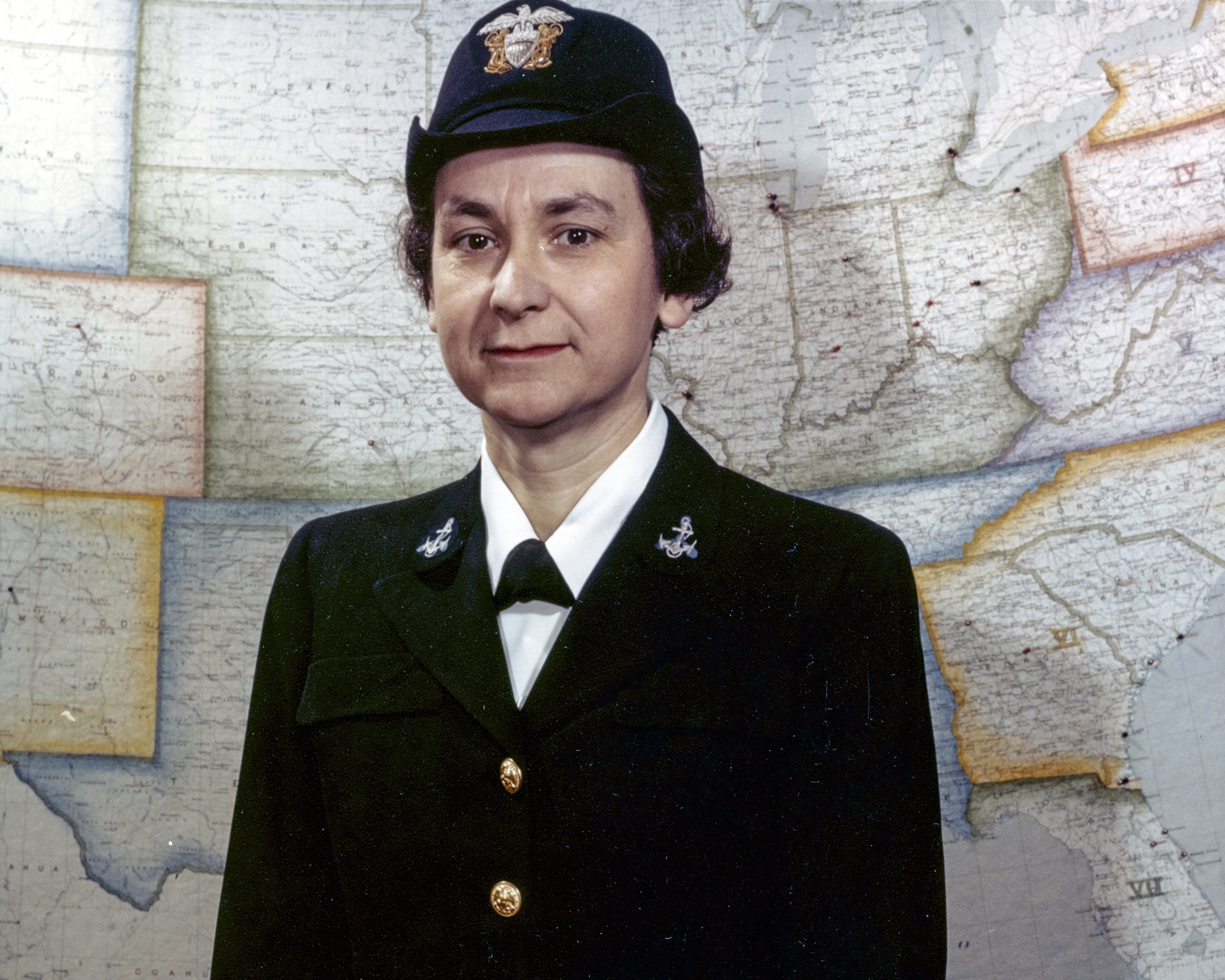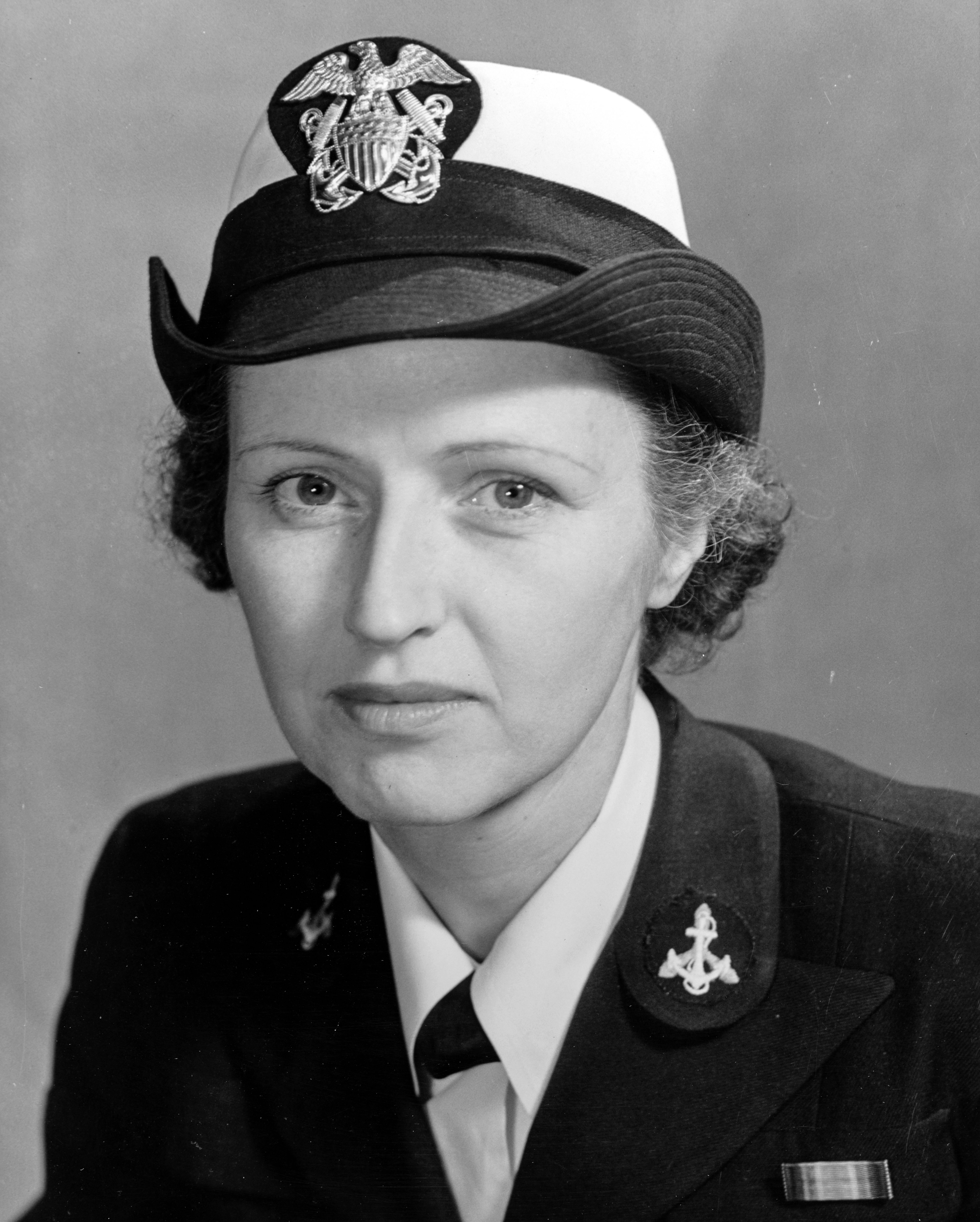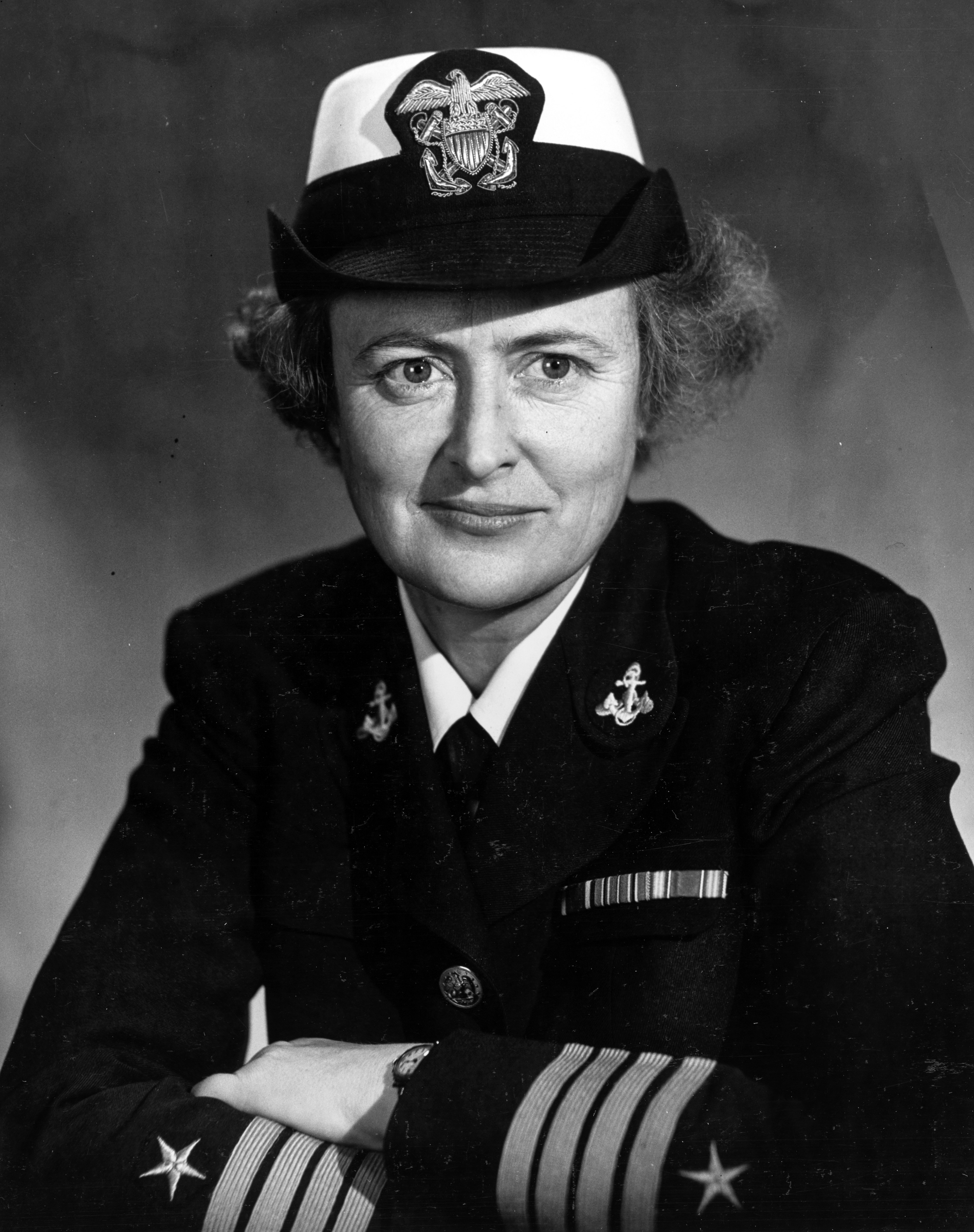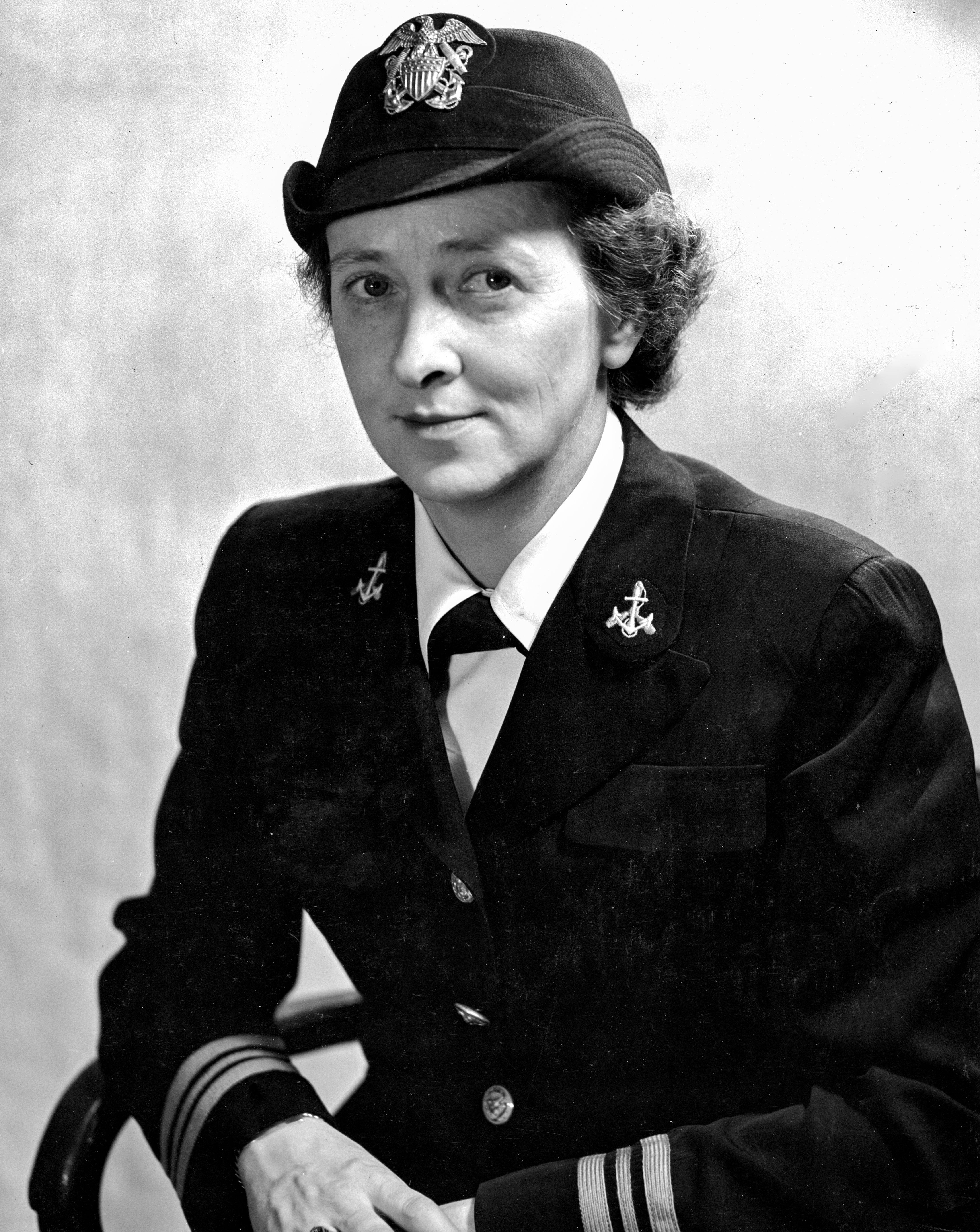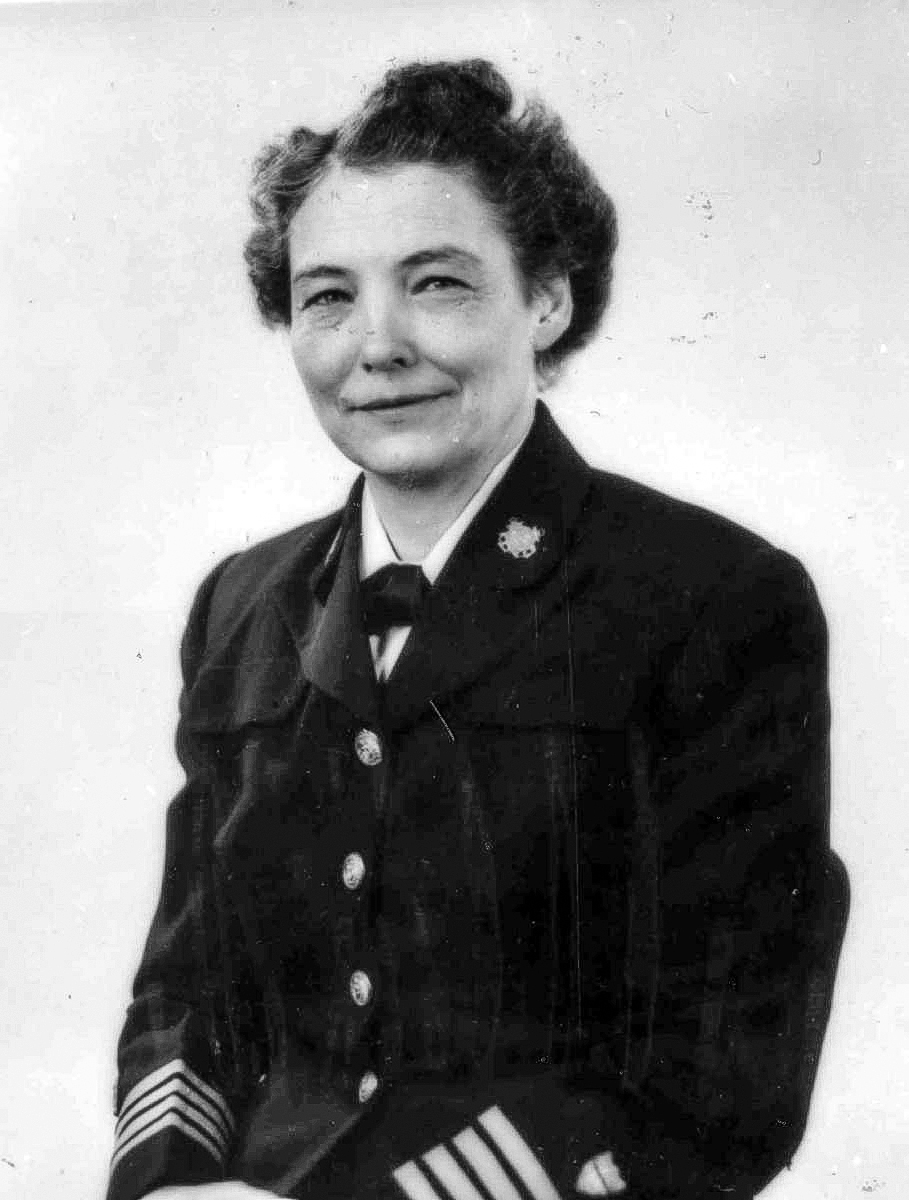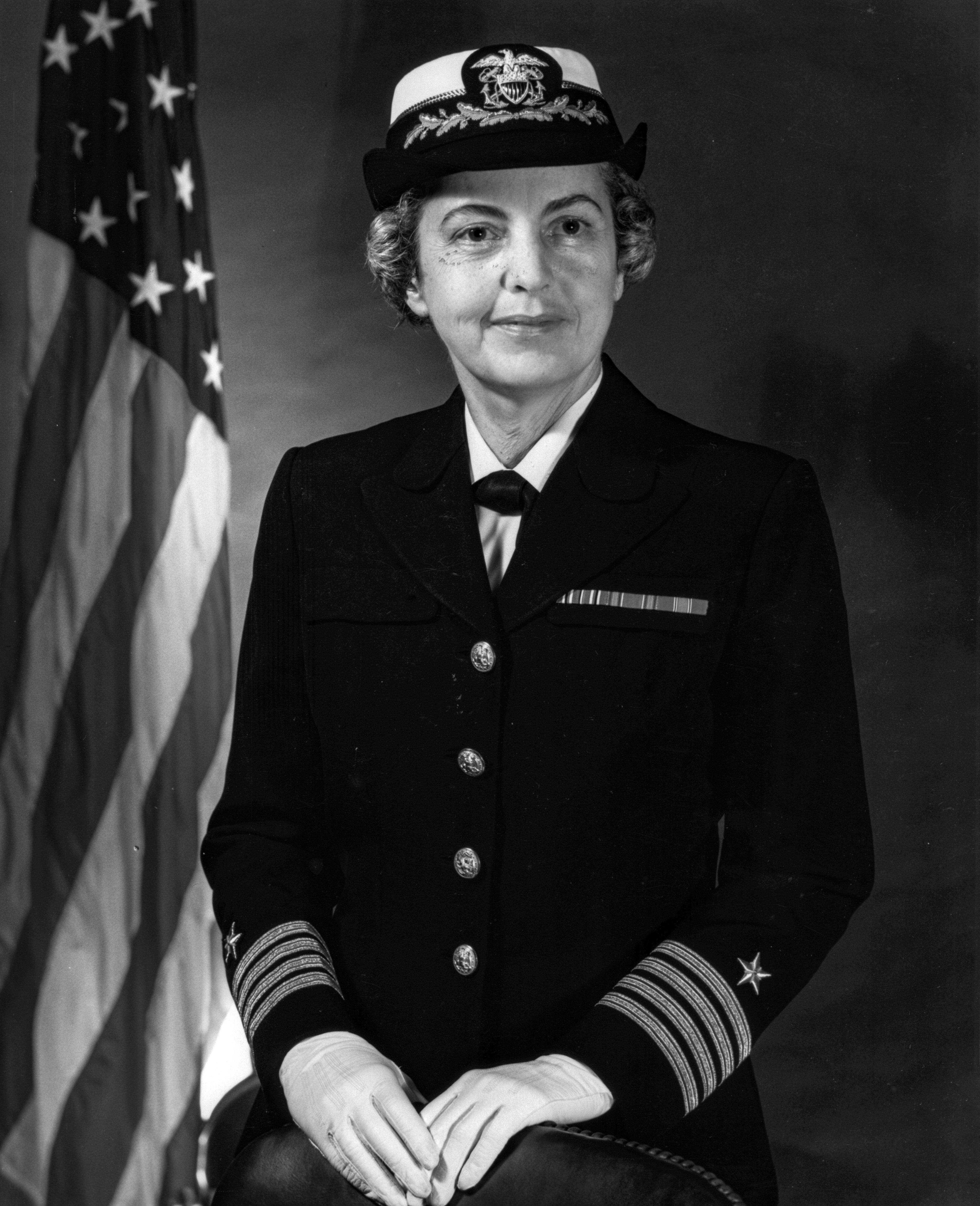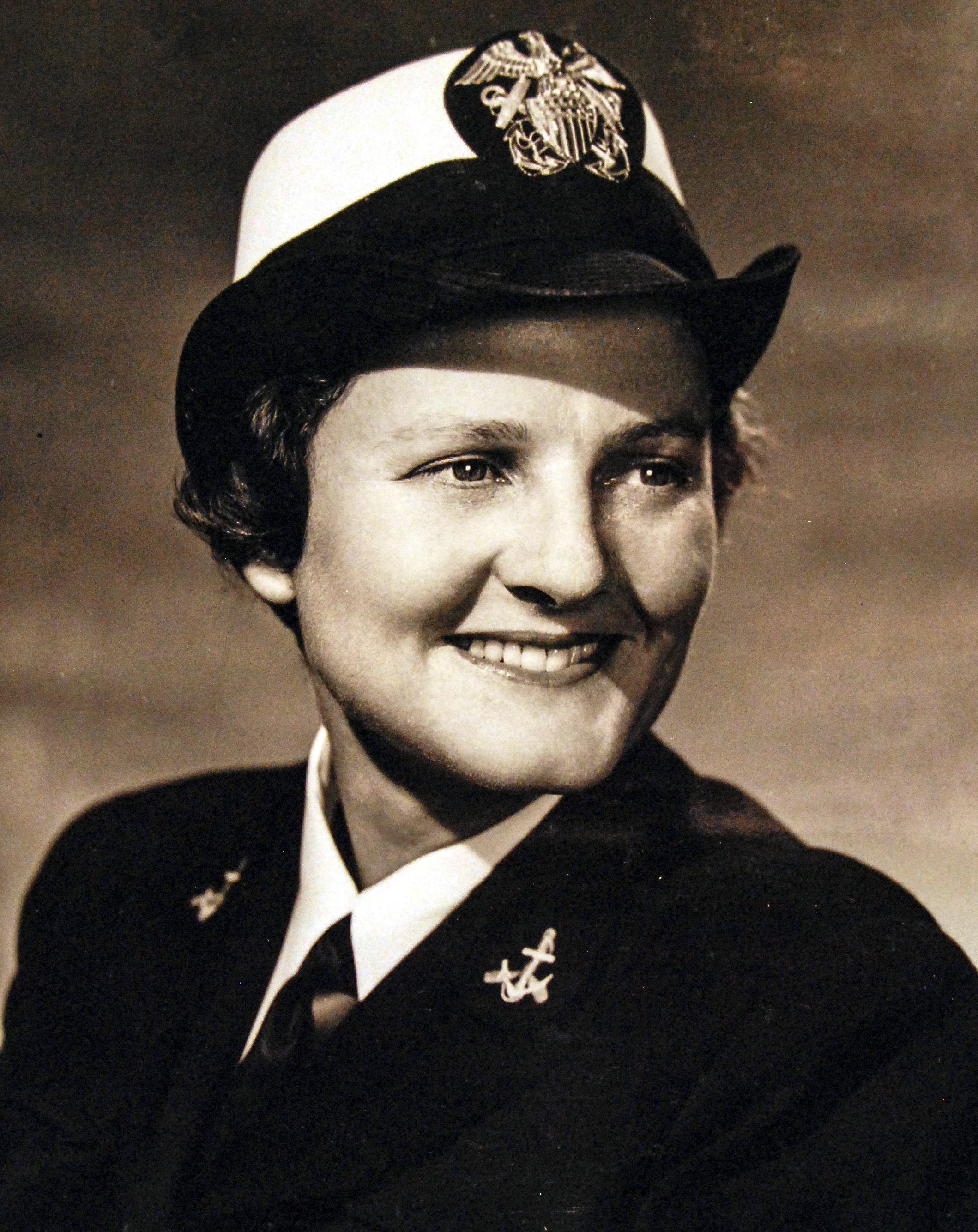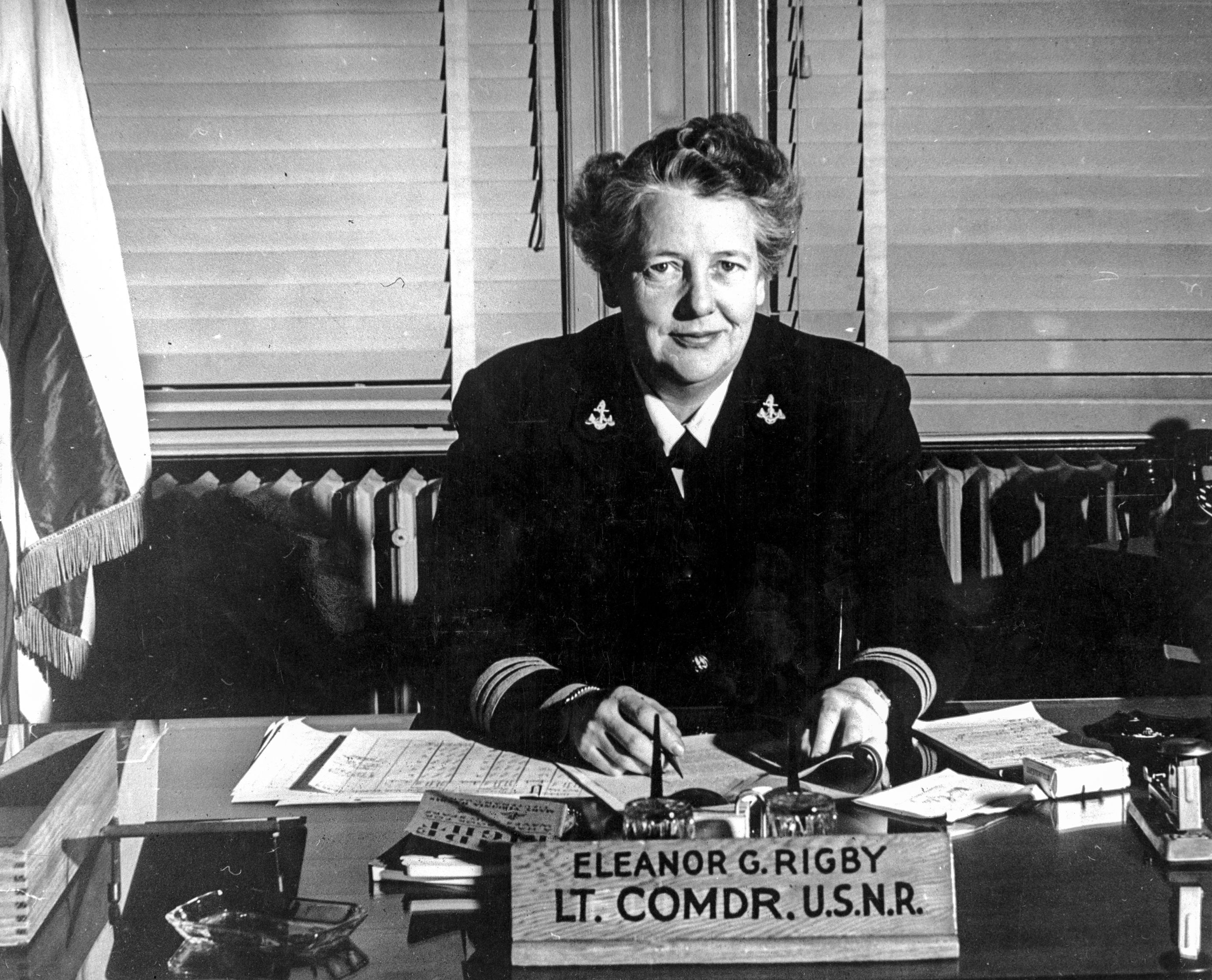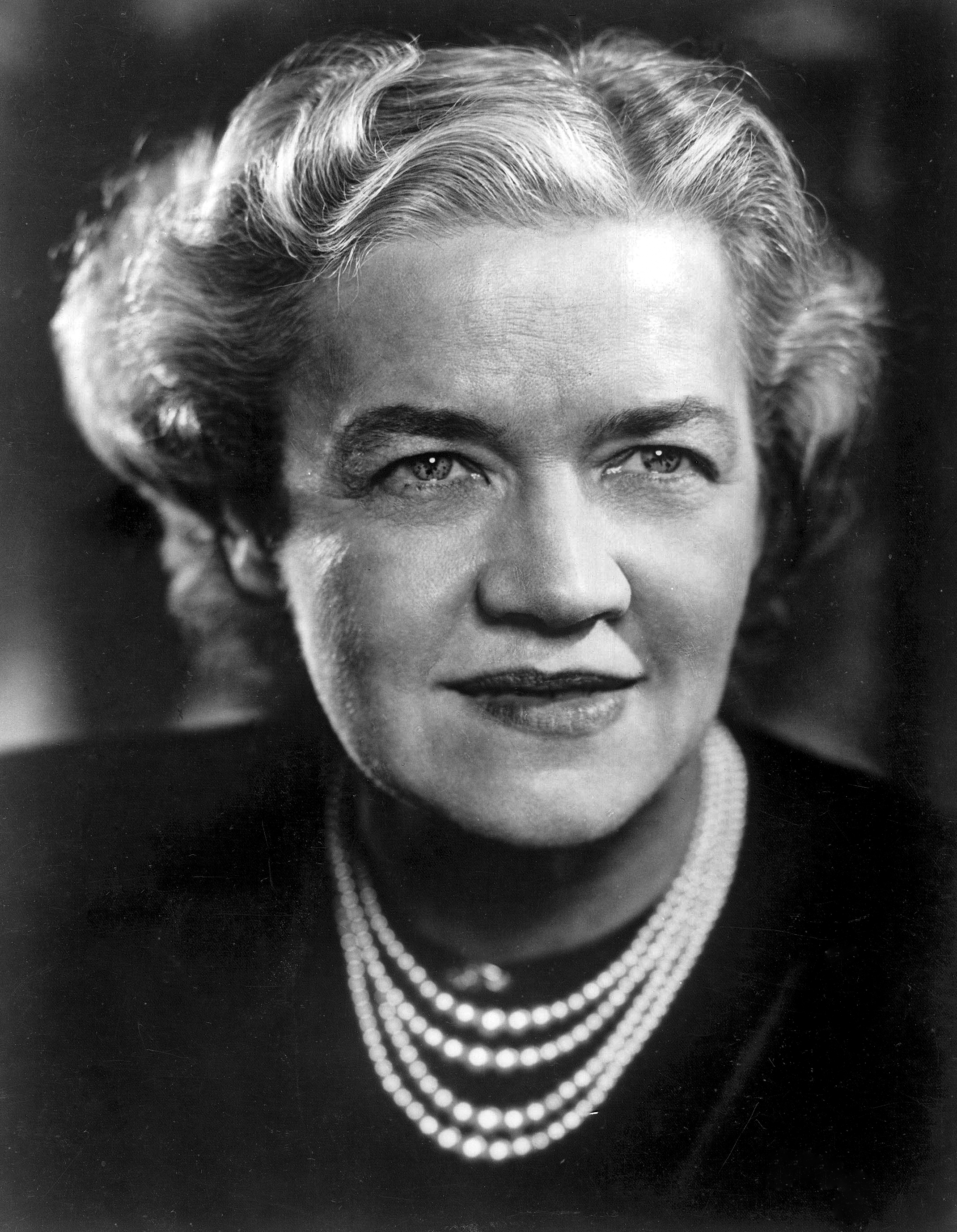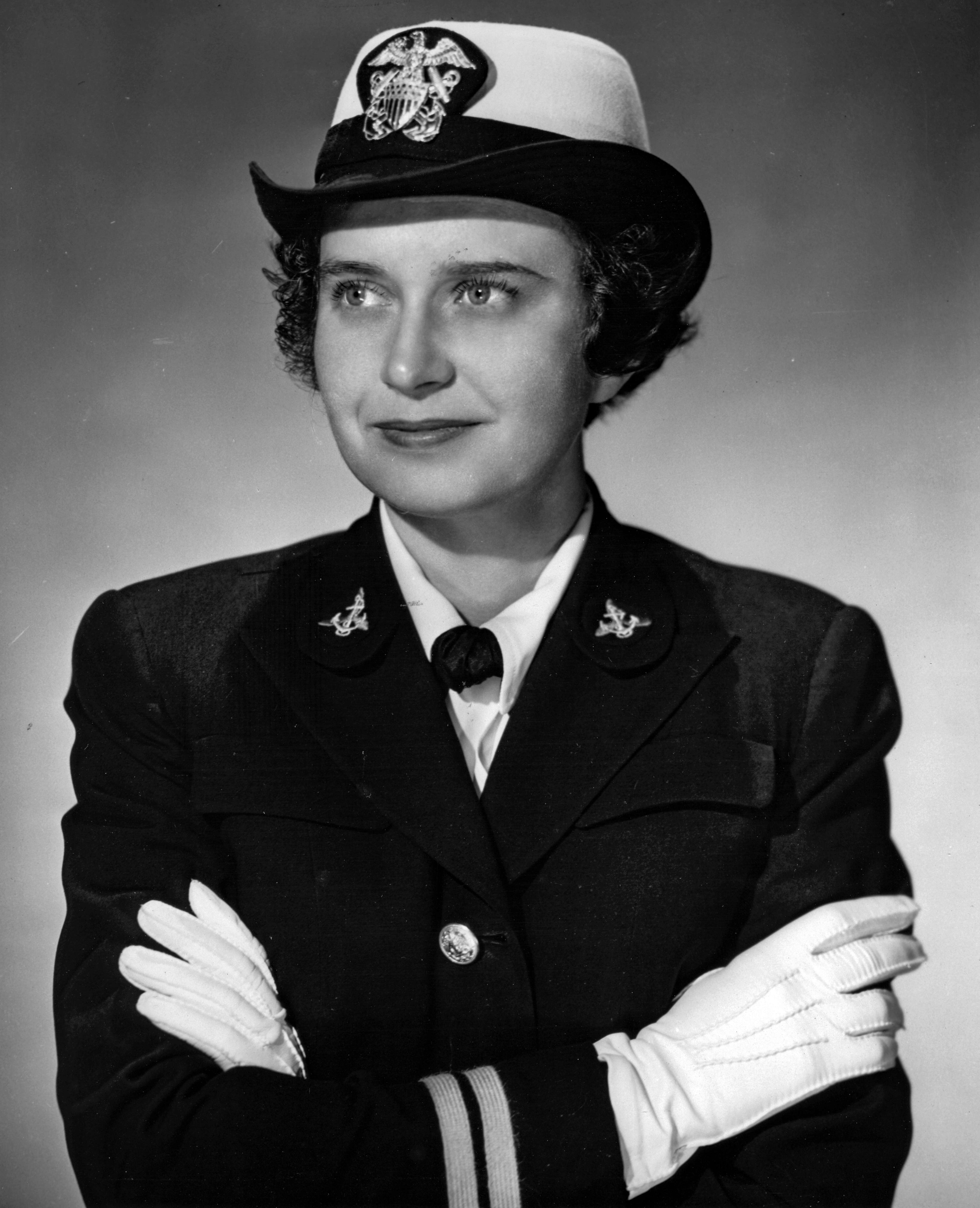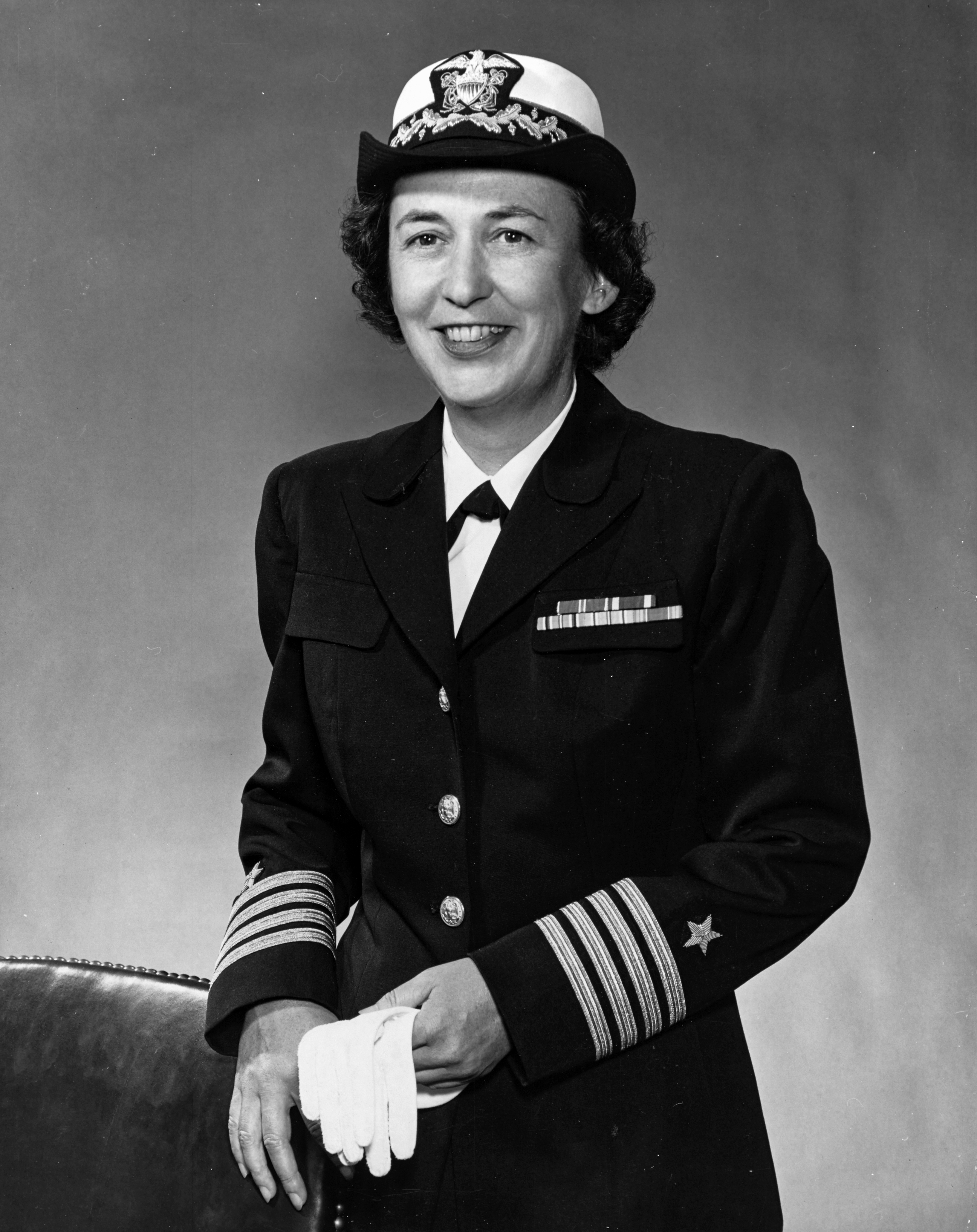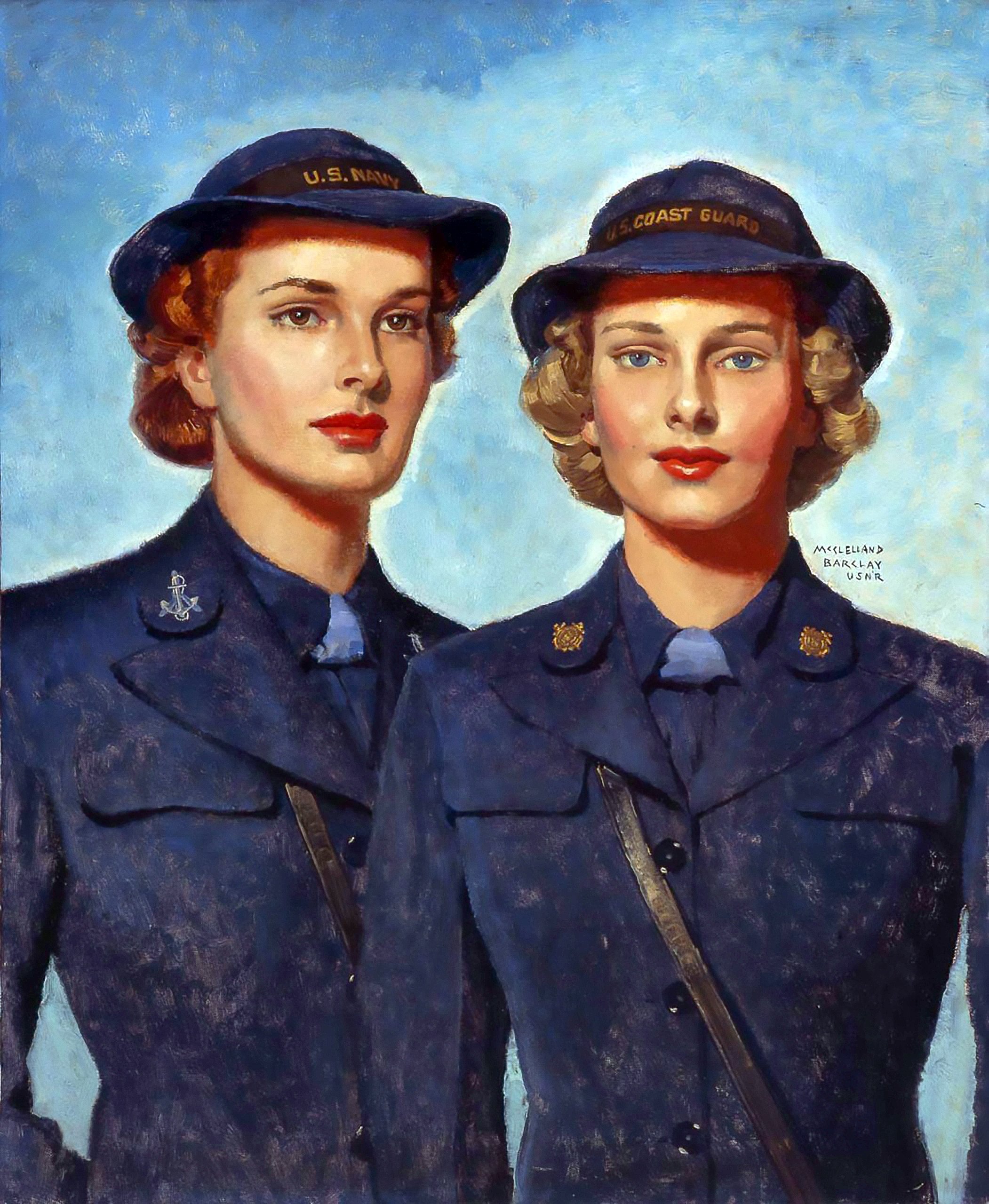
WAVES, The
(Volumes I and II)
The Women Accepted for Volunteer Emergency Service—better known in history as the WAVES—were the crucial women’s Naval Reserve component of the U.S. fleet during its most epochal years—World War II. The WAVES were in many ways unprecedented, and the obstacles they faced, both minor and significant, were numerous. From 1969 to 1971, Naval Institute oral historian John T. Mason Jr. and his West Coast operative, Etta Belle Kitchen, sought to recapture some of this unique aspect of the story of the Navy in the Second World War, and in the process preserved some vital insights into what amounted to a precursor to the gender-integrated force of today. The WAVES recollections they gathered comprise two volumes of essential primary-source history.
Horton, Mildred McAfee, Capt., USN (Ret.), 1900–1994
Horton left her position as president of Wellesley College in 1943 to become the first director of the Women's Reserve. She recalls her difficulties concerning uniforms, integration, and prevailing attitudes about the "correct" use of the women. Two interviews in August 1969; transcript contains 115 pages.
Note: Due to edits, corrections, and/or amendments to the original transcription draft, there are some inconsistencies between the recording and the text.
John T. Mason, Jr.: Well, tell me about your first connection with the WAVES. How did you get drawn into the picture?
Captain Mildred McAfee Horton: It was shortly after Pearl Harbor, I guess, sometime that winter, the man who was working on personnel in Admiral King's office, then Chief of Naval Operations, had been a dean of engineering at Columbia. You can find his name, but it just escapes me. I can't think of it at the moment. Anyway, he had enlisted Miss Gildersleeve at Barnard and a professor, Miss Reynard, — Reynard the Fox, she used to call herself — to help him consider the question of women in the service. And so Miss Gildersleeve at Barnard called a conference of the executives of a large variety of women's colleges — I think the deans of several co-educational colleges — quite a group of women were present at a meeting at Barnard. I don't have the date of it and I don't know that I have any record of it, but at that time we were told that there was the likelihood that women would be admitted to the Navy, and that it was their hope that we would encourage recruiting for this. The officer who told us about this, as I recall it, was a man by the name of Hartenstein, who was at the University of Pennsylvania until he had joined the Navy. Bert Hartenstein. His name was Paul B., and I don't know why he was called Bert, but that was it. And he was very enlightening about the kinds of things which women might be asked to do, and then the meeting adjourned. And the next I knew...
John T. Mason, Jr.: You had come down for this meeting...
Captain Mildred McAfee Horton: I just came down from Wellesley to hear what it was all about.
John T. Mason, Jr.: This was called on the spur of the moment, I believe.
Captain Mildred McAfee Horton: Yes, fairly quickly, as I recall it, and in response to the emergency and we were all eager to do our bit, and everybody was eager to know what would happen to colleges and the students in them, and so on. I don't recall, really, the very next thing I heard except that I think it was by way of Miss Gildersleeve, who wrote me to ask if I would accept this appointment, and it never...
John T. Mason, Jr.: They had this new organization?
Captain Mildred McAfee Horton: They were going to have this new organization, and I think it was right at that time that it was explained to me that the Navy had decided that it was going to have somebody at the head of this organization who was not politically related or known, and they had decided to try to get a college president on the principle that the Navy knew enough about the Navy, but they didn't know much about girls, and that somebody who had been working with young women would be the kind of person they'd look for.
John T. Mason, Jr.: And you say the college president had to be the president of a women's college.
Captain Mildred McAfee Horton: Well, that's the only kind of woman president there is, I guess. And, furthermore, this was the real trick of it, the Congress had limited the rank to that of a lieutenant commander, and one thing which we had been insisting upon at this meeting, and which the Navy was entirely in sympathy with, was that women should not have special privileges, they should conform to the regulations, and that meant that the director, who was to be the only lieutenant commander — this high-ranking impressive thing, see — must be within the ages of a lieutenant commander being brought in from civilian life. I happened to be the one within the age bracket who was young enough to fall in that low rank.
John T. Mason, Jr.: That was a factor, then...
Captain Mildred McAfee Horton: I'm sure it was, oh, yes...
John T. Mason, Jr.: I believe from what I've read, that another very important factor — and a much more important one, perhaps — was that you could bring to the organization a kind of prestige and respectability.
Captain Mildred McAfee Horton: The theory definitely was that in appointing anybody to be the head of this, they wanted to assure the parents and boyfriends of girls that they would be looked after in the Navy. That this was not going to be a wild show, but it would be respectable, and the president of a woman's college — the reason they chose that category to begin with, was with the thought that somebody who had been accustomed to dealing with girls and was in a position which had respect attached to it would enhance getting the right kind of person into the service.
John T. Mason, Jr.: Were women at that moment enrolled in the Army, as WACS and the Marine Corps?
Captain Mildred McAfee Horton: Yes — no, not the Marine Corps, just the WACs. They were the only one when we started up, and I think it's fair to say that the limitations of this general intent of a category to select from, and the age bracket, were really the things which made them approach me about it. In her autobiography, Miss Gildersleeve had a reference to this selection of me in this position, and was incensed and said she simply could not understand why it was that the Trustees of Wellesley College raised a real question about whether I should be released from my commitment to them for the sake of doing this.
John T. Mason, Jr.: And did they?
Captain Mildred McAfee Horton: The thing that happened was that she came up to Boston to talk with them about my going to the Navy. If I remember correctly, I had had no direct communication from the Navy, and it hadn't occurred to me that this advisory woman who had been called in a consultative — for consultation – was really authorized by the Navy to appoint an officer. So that as we talked with her and when the Trustees talked with her, they were very skeptical about whether this new venture was one that was really going to be bought by the Navy. You see, they thought it was...
John T. Mason, Jr.: Thought it wasn't official.
Captain Mildred McAfee Horton: ...entirely unofficial. Moreover, I remember one of our Trustees had a son in the service and he said to me, "You don't want to get mixed up in anything where your rank is that of a lieutenant commander. That's not enough to carry any weight." And I had no notion, I didn't know the ranks at all. I knew nothing about it.
John T. Mason, Jr.: Well, had you expressed your willingness to...?
Captain Mildred McAfee Horton: No, I hadn't expressed anything. They came and asked if I would do this, you see, and the inquiries that we were making seemed to Miss Gildersleeve just utterly unpatriotic. I mean you ought to be ready to jump the minute you're asked. But we weren't at all sure who was asking. Well...
John T. Mason, Jr.: You hadn't been really completely informed of the background on it.
Captain Mildred McAfee Horton: No, so when she was there with us, I said that I certainly was willing to go to Washington and talk with the Chief of Naval Personnel and find out what it was all about. So, I did go, and I talked to Admiral Jacobs. I've often laughed at him, and with him, on this, but I said, "Now, I don't know a thing about ranks in the Navy, but one of my Trustees has said that he thinks it's debatable whether I really ought to leave a position which really has as much responsibility as the presidency of the college, for something at this rank of lieutenant commander." And he said, "Why, think nothing of that. In the Navy anybody who's in charge of anything, is the ranking officer there. In a little small boat it might be an ensign, but his word is law. And this is just a technical congressional requirement. It doesn't mean a thing. You'll be in charge, and this will be your baby."
Well, the fact of the matter was that for me and for many — scores — of the women who came in, this matter of rank really didn't mean anything. It just didn't matter… I mean if it was a job...
John T. Mason, Jr.: You came to do a job.
Captain Mildred McAfee Horton: We came to do a job and we didn't know enough to know that rank would make any difference. I remember how perfectly appalled we were very early in the game when, at one of the first training schools, they sent out word that the school would be commanded by a man officer, and then there would be a woman executive officer, and there was to be a woman who was to be in charge of the actual instruction in the skill, whatever it was, I think it was secretarial skills, and the girl in the procurement office worked slavishly to find the right people and sent them down. One qualified to be a general administrator, and one to be a teacher, and they got there and found to the horror of everybody that the teacher outranked the executive by one day, and the young man who had been assigned at his first step from civilian life to be the commanding officer of this thing simply said, "We can't do this in the Navy. We simply can't do this. The ranking officer with seniority has got to count in this." And we thought it was just asinine, so silly. But I noticed that very soon after, people began to be sensitive about seniority, and then they soon caught the spirit about it, but at first it just literally made no difference.
John T. Mason, Jr.: You were fresh from civilian life. This rank was written into the law was it?
Captain Mildred McAfee Horton: It was written into the law.
Hancock, Joy Bright, Capt., USN (Ret.) (1898–1986)
Hancock's naval service spanned three wars, starting with duty as a Yeoman (F) in World War I. From her service in the Bureau of Aeronautics in the early 1920's, she recalls her dealings with Admiral William A. Moffett and other early naval aviators. She later was the third director of the WAVES from 1946 to 1953. Three interviews from November 1969 through March 1970; transcript contains 139 pages.
(Note: Due to edits, corrections, and/or amendments to the original transcription draft, there are some inconsistencies between the recording and the text.)
John T. Mason, Jr.: Well, tell me about the struggle to get the legislation. You worked through — BuAer worked through Mel Maas, didn’t they?
Captain Hancock: Yes. We couldn't — you see we couldn't — I say we, I'm speaking of the Bureau of Aeronautics, Admiral Towers, Captain Radford–
John T. Mason, Jr.: But you were the publicity agent at that —
Captain Hancock: Yes, but at that time I was not only publicity but I was doing this WAVE program about which they said, "All right you want to get in, don't you?" I said, "Sure." "Well, then we've got to get these plans together." I was doing a lot of that work in addition to my public relations job. And BuAer couldn't really go in and say we want so-and-so legislation. I mean you don't do that. It was BuPers's prerogative and they weren't going to do it. So there was —
John T. Mason, Jr.: That was Admiral Jacobs at that point?
Captain Hancock: I'm not sure it was Admiral Jacobs at that time. I've forgotten. The first bill was really introduced by Representative Mel Maas and Senator Willis. Behind its introduction is quite a story. There was an organization known as the Sons of Mom Chung. Have you ever heard of it?
John T. Mason, Jr.: No.
Captain Hancock: Admiral Nimitz belonged. It was only for aviators in its beginning and then she opened it up to submariners. Dr. Chung was in San Francisco.
John T. Mason, Jr.: Oh, I've heard of her. Yes, yes. Mom?
Captain Hancock: Mom Chung. C-H-U-N-G, Dr. Margaret Chung.
John T. Mason, Jr.: I think I heard of her through Miss Wilde.
Captain Hancock: Yes, well, she's a marvelous character. Mel Maas was one of her Sons.
John T. Mason, Jr.: He was?
Captain Hancock: Yes. I mean "Sons." All the members were "Sons" including now Admiral McQuiston, who was in the Reserve Section of the Bureau. Irving McQuiston. And Mom Chung came to town to see what she could do for the war effort. Aviation wanted the legislation to enroll women -- what would she do to help? It was decided that she would go up and see Mel Maas, one of her Sons and say, "Why don't you introduce a bill? I want to get in the Navy." She did want to come in as a doctor. That she didn't make It always sort of broke my heart. For she had done so much for us. Mom Chung went up to see Mel Maas and said, "Look, we need some legislation. There is need for women in the Navy. Aviation needs them."
Mel Maas, of course, was in Marine Corps aviation and he said, "All right, Mom." And without further ado he called Senator Willis, a friend of his, from the middle West, and they introduced simultaneous bills on March 18, 1942, in the House and in the Senate, stipulating, "This is the authority to enroll women ..."
John T. Mason, Jr.: This would be an amendment to the Reservist Act, wouldn't it?
Captain Hancock: Yes, to the Naval Reserve Act of 1938. "—into the reserve and introduced them." In the meantime the WAC legislation had been introduced by Edith Nourse Rogers and she called BuPers and asked if they had any legislation in and they said no, and they didn't intend to put any in. She said. "I understand that a bill was just introduced on the floor of the House for that purpose and what are you going to do about it?" And that was the start of the -- Of course, those two bills were still in committee. When BuPers got busy and requested a bill that they felt would be better coverage. This was introduced May 14, 1942 by Senator David Walsh as a "Women's Auxiliary Corps" bill. Final legislation was not enacted until July 1942.
John T. Mason, Jr.: And BuPers was then actually activated by a kind of a back fire?
Captain Hancock: Oh yes. And then the -- it's in the records in the archives and everywhere else that then they visualized at the most a total of 10,000 women.
John T. Mason, Jr.: Headed by a lieutenant commander.
Captain Hancock: Yes, one lieutenant commander. However, only a total of 10,000 women was visualized. That was the number that had been used in World War I. As it turned out they enrolled 100,000 instead of 10,000. As soon as that ball started rolling and they were framing legislation, BuAer sent over their 23,000 request and BuPers (I've a copy of the letter) said, "We had only visualized 10,000. We will now adjust our thinking and try to set up recruiting to get — as soon as the bill passes — to get the numbers you need."
John T. Mason, Jr.: Well, BuAer had by that time become much more respectable.
Captain Hancock: Oh yes. This was in ’4l.
John T. Mason, Jr.: The fortunes of the WAVES rode on the respectability and credibility of BuAer.
Captain Hancock: And desirability of their services. And at that same time, of course, BuAer said when they're taken in we want to train our own women, and we will do it in already existing schools so that there will be no additional expense. This was done. They were integrated into the overall Navy program.
John T. Mason, Jr.: Is this a part of your planning, too?
Captain Hancock: Yes. And that has held and is still holding. They go to the same schools and they compete in class standing with the men, so that when they go on the job, say for instance the aviation mechanic, the men they're working next to don't say, "Oh yeah, you don't know from nothing." For the men know they had had the same course, they had taken the same examinations.
John T. Mason, Jr.: Well, I take it from what you’ve told me that you were pretty basic to the planning then.
Captain Hancock: Well, actually, I was for naval aviation. Simply because I was drawn into the planning by the persons heading up aviation, Admiral Towers, Capt. Radford, and all the people I had known all my life. They knew I had a background in aviation, they knew I had World War I service, and I think they felt I was competent in going ahead with this work, and they really threw it to me. But certainly, all along the way, it was their direction, their help, and their imagination that did it. At times I felt somewhat like the peg in a game of quoits. But I was in a position to know the plans from the ground up. I think that’s one of the reasons why Capt. McAfee later said in a letter to me on my history of the WAVES, "You write it. You were in before it started. And you know it from the ground up."
John T. Mason, Jr.: Were you eager for this new job that was being offered?
Dr. Stratton: I knew nothing about the Coast Guard, nothing. I had never seen a Coast Guard officer. I didn't know anything. I think I felt if that was the place where I could work, that was fine with me. In other words, I only cared about being where I could feel I was doing something useful, and I thought this would be useful.
I got to Washington and, as I say, I was on loan from the Navy to the Coast Guard.
John T. Mason, Jr.: Did you have a conversation with Mildred McAfee at that point?
Dr. Stratton: I don't think I did, no. I didn't see her, as I recall it, but she was extremely helpful in getting the SPARS underway.
After we got the legislation on the 23rd of November I was sworn in on the 24th. I asked Miss McAfee if it would be possible to get a nucleus of the WAVE officers to start us off because it would save such an enormous amount of time. She said as far as she was concerned, "Yes," and the Navy said, "Yes."
So I went back then to Northampton and made a plea to women who were there in training and got twelve of the WAVES who were getting their indoctrination to come to the Coast Guard and help us get started.
John T. Mason, Jr.: Were they volunteers or did you select them?
Dr. Stratton: They were volunteers. Unless they wished to come I couldn't have got them. But there were some who thought, "Here's a new Service and it's a chance to help get this on its way." By getting the twelve officers, who were tremendously helpful, it saved us a lot of time.
John T. Mason, Jr.: I'm sure it did.
Would you mind going back, and telling me what happened, what you did in the interim between your selection by the Coast Guard Admirals and the passage of the legislation?
Dr. Stratton: I'd be glad to tell you.
First of all I had to find a place to live and there wasn't any place to live in Washington. So finally at the American Association of University Women, which was then at 1634 I street, I got a sort of enlarged closet which had a couch in it. It had nothing else, but it was all there was. I said, "I'm not going to be here much anyway. I'll take anything." So I got this little room, which had a window opening on the shaft. You never could tell whether the sun was shining or it was raining or what.
John T. Mason, Jr.: About that time you probably thought, "Oh why can't I be back at Purdue."
Dr. Stratton: I was glad to get it.
Then came the question - what were we going to call this unit of the Women's Reserve of the Coast Guard? The WAACS had a name and the WAVES had a name, so what were we going to call the Women's Reserve of the Coast Guard?
There wasn't anyone else except me to think about this. Everybody else had his mind on more important things.
So I tossed on that hard bed many nights trying to think what we'd call this organization. Some times when you just absolutely have to do something you do it. Suddenly it came to me from the Motto of the Coast Guard - "Semper Paratus - Always Ready - SPAR."
I proposed it to the Commandant and his Assistants. They accepted it and that was it. So that was one thing that I did.
John T. Mason, Jr.: Where did you have your desk at that point?
Dr. Stratton: I had a desk at the Coast Guard Headquarters.
A Commander Carroll, who was in charge of procurement there, got me a desk and fixed me up.
Of course the Coast Guard wasn't air conditioned and we had wool uniforms. We not only had them that summer, we had them the next summer too. They never did have any air conditioning in my experience there, but that was not very important in the total scheme of things.
What else did I do? We had to decide what the women were going to wear. The WAVES already had a very good looking uniform designed by Mainbocher, as you know. Somebody in the Coast Guard had also designed a uniform for the SPARS, some man I think had designed the uniform. So which one was going to be chosen?
With great solemnity a whole room full of Admirals sat around and decided which uniform was the one to be worn. They finally decided on the WAVE uniform, with the Coast Guard insignia, which, was a good idea because it was very useful and a very good looking uniform.
Palmer, Jean, Capt., USNR (1903–1992)
Palmer became the second director of the WAVES in 1946. She discusses her wartime service in Washington, political influences on the budding WAVES program, and assesses her predecessor, Mildred McAfee Horton. One interview in May 1969; transcript contains 53 pages.
Shelly, Mary-Josephine, Lt. Cdr., USNR (Mary Jo) (1902–1976)
Shelly adds her recollections of duty as the WAVES training representative in the Bureau of Personnel during World War II. Later, she became Colonel Shelly, USAFR, recruited by the Air Force to head its women's program. One interview in February 1970; transcript contains 68 pages.
Stratton, Dorothy, Capt., USCGR (1899–2006)
Stratton was selected as a senior Navy lieutenant at the beginning of the war to head the Coast Guard's budding women's program, which she named the SPARs. One interview in September 1970; transcript contains 76 pages.
John T. Mason, Jr.: Were you eager for this new job that was being offered?
Dr. Stratton: I knew nothing about the Coast Guard, nothing. I had never seen a Coast Guard officer. I didn't know anything. I think I felt if that was the place where I could work, that was fine with me. In other words, I only cared about being where I could feel I was doing something useful, and I thought this would be useful.
I got to Washington and, as I say, I was on loan from the Navy to the Coast Guard.
John T. Mason, Jr.: Did you have a conversation with Mildred McAfee at that point?
Dr. Stratton: I don't think I did, no. I didn't see her, as I recall it, but she was extremely helpful in getting the SPARS underway.
After we got the legislation on the 23rd of November I was sworn in on the 24th. I asked Miss McAfee if it would be possible to get a nucleus of the WAVE officers to start us off because it would save such an enormous amount of time. She said as far as she was concerned, "Yes," and the Navy said, "Yes."
So I went back then to Northampton and made a plea to women who were there in training and got twelve of the WAVES who were getting their indoctrination to come to the Coast Guard and help us get started.
John T. Mason, Jr.: Were they volunteers or did you select them?
Dr. Stratton: They were volunteers. Unless they wished to come I couldn't have got them. But there were some who thought, "Here's a new Service and it's a chance to help get this on its way." By getting the twelve officers, who were tremendously helpful, it saved us a lot of time.
John T. Mason, Jr.: I'm sure it did.
Would you mind going back, and telling me what happened, what you did in the interim between your selection by the Coast Guard Admirals and the passage of the legislation?
Dr. Stratton: I'd be glad to tell you.
First of all I had to find a place to live and there wasn't any place to live in Washington. So finally at the American Association of University Women, which was then at 1634 I street, I got a sort of enlarged closet which had a couch in it. It had nothing else, but it was all there was. I said, "I'm not going to be here much anyway. I'll take anything." So I got this little room, which had a window opening on the shaft. You never could tell whether the sun was shining or it was raining or what.
John T. Mason, Jr.: About that time you probably thought, "Oh why can't I be back at Purdue."
Dr. Stratton: I was glad to get it.
Then came the question - what were we going to call this unit of the Women's Reserve of the Coast Guard? The WAACS had a name and the WAVES had a name, so what were we going to call the Women's Reserve of the Coast Guard?
There wasn't anyone else except me to think about this. Everybody else had his mind on more important things.
So I tossed on that hard bed many nights trying to think what we'd call this organization. Some times when you just absolutely have to do something you do it. Suddenly it came to me from the Motto of the Coast Guard - "Semper Paratus - Always Ready - SPAR."
I proposed it to the Commandant and his Assistants. They accepted it and that was it. So that was one thing that I did.
John T. Mason, Jr.: Where did you have your desk at that point?
Dr. Stratton: I had a desk at the Coast Guard Headquarters.
A Commander Carroll, who was in charge of procurement there, got me a desk and fixed me up.
Of course the Coast Guard wasn't air conditioned and we had wool uniforms. We not only had them that summer, we had them the next summer too. They never did have any air conditioning in my experience there, but that was not very important in the total scheme of things.
What else did I do? We had to decide what the women were going to wear. The WAVES already had a very good looking uniform designed by Mainbocher, as you know. Somebody in the Coast Guard had also designed a uniform for the SPARS, some man I think had designed the uniform. So which one was going to be chosen?
With great solemnity a whole room full of Admirals sat around and decided which uniform was the one to be worn. They finally decided on the WAVE uniform, with the Coast Guard insignia, which, was a good idea because it was very useful and a very good looking uniform.
Crandall, Elizabeth B., Cdr., USNR (1906–1985)
As ranking woman officer at the Smith College training facility, Crandall discusses discipline imposed on the women, the lack of supplies allocated to their training program, and other situations she encountered there. In 1943 she was assigned to the staff of Commandant, Third Naval District, where she was faced with the logistical problems of organizing the women attached to various commands in New York. One interview by Kitchen in July 1970; transcripts contains 56 pages.
Kitchen, Etta-Belle, Cdr., USN (Ret.) (1907–1997)
This former lawyer joined the women's reserve in 1942 and saw wartime duty at the shipyard in Bremerton. After the armistice, she left the Navy for two years, and in 1948 was one of only six women selected for lieutenant commander in the regular Navy. Her final tour was as commanding officer of the recruit training center at Bainbridge, Maryland in the early 1960s. One interview by Mason in May 1969; transcript contains 20 pages.
Lenihan, Rita, Capt., USN (Ret.) (1915–1989)
A career naval officer who retired in the mid-1970s, Lenihan came to the Navy in 1943 from a position as a home lighting engineer. She recalls her work with real estate acquisitions for the Navy and congressional appearances from her wartime service. One interview by Mason in September 1970; transcript contains 43 pages.
Rich, Frances L., Lt. Cdr., USNR (1915–1989)
Rich came to the Navy as a civilian engineer draftsman at Lockheed. She returned to her alma mater – Smith College – for training and describes that process and the personnel there. She discusses V-mail from her experiences in the Navy's communications department and the general attitudes of the WAVES. One interview by Kitchen in September 1969; transcript contains 71 pages.
Rigby, Eleanor G., Cdr., USNR (1896–1974)
Rigby returned to her alma mater, Smith College, first to go through naval training, and then was tapped to stay there on the training staff. From her experiences in this position she provides a thorough description of life for Navy women during the hectic days of World War II. After legislation was passed in 1944 allowing women overseas, she was among the first women sent to Hawaii. One interview by Kitchen in July 1970; transcript contains 60 pages.
Smith, Margaret Chase, Senator from Maine (1897–1995)
Smith, a supporter of the movement to utilize women in the military and champion of their efforts to obtain permanent status, discusses key congressional figures concerned with the issue of service women. She also discusses her role in this and her relations with the top-ranking Navy women. One interview by Mason in June 1969; transcript contains 13 pages.
Wiley, Tova P., Cdr., USNR (1903–2001)
Hesitantly plucked from a training position at a large department store to be a procurement officer, Wiley describes recruiting tactics and anecdotes from her service. She also discusses recreational facilities and living arrangements for WAVES. One interview by Kitchen in September 1969; transcript contains 60 pages.
Wilde, Louise K., Capt., USN (Ret.) (1942–1979)
In describing her entry into naval service, Wilde discusses the arbitrary assignment of ranks by local procurement offices and the fine reputations of the women holding key WAVES positions. Wilde's specialty became public relations, where it was necessary to support the women's position in the service to the civilian population. One interview by Mason in December 1969; transcript contains 46 pages.
About Volume I
Based on eight interviews conducted by John T. Mason Jr. from May 1969 through September 1970, the volume contains 451 pages of interview transcript plus indices. The transcript is copyright 1971 by the U.S. Naval Institute; any restrictions originally placed on the transcripts by the interviewees have since been removed.
About Volume II
Based on eight interviews conducted by John T. Mason, Jr., and Etta-Belle Kitchen from May 1969 through September 1970. The volume contains 369 pages of interview transcript. The transcript is copyright 1979 by the U.S. Naval Institute; any restrictions originally placed on the transcripts by the interviewees have since been removed.




